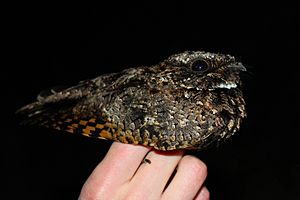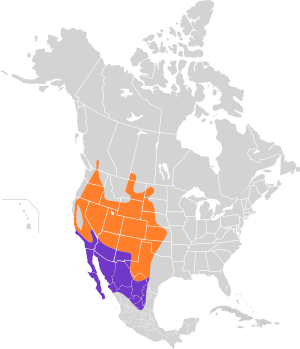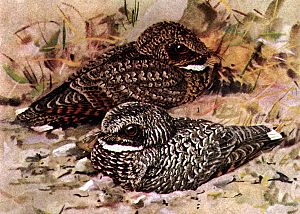Common poorwill facts for kids
Quick facts for kids Common poorwill |
|
|---|---|
 |
|
| Conservation status | |
| Scientific classification | |
| Genus: |
Phalaenoptilus
|
| Species: |
nuttallii
|
 |
|
| Synonyms | |
|
Camprimulgus nuttallii (protonym) |
|
The common poorwill (Phalaenoptilus nuttallii) is a unique bird that is active at night. It belongs to a group of birds called nightjars. You can find this bird in many places, from British Columbia in Canada, through the western United States, all the way to northern Mexico. It likes to live in dry, open areas with grass or small bushes, and even rocky desert hills where there isn't much plant life.
Many common poorwills that live in the northern parts of their range will migrate south for the winter. They travel to central and western Mexico. However, some poorwills stay further north. The common poorwill is the only bird known to go into a deep sleep called torpor for a very long time, sometimes weeks or even months! This usually happens in the southern parts of its range in the United States. During this time, it stays hidden in piles of rocks. This long period of torpor is very much like hibernation, which is something we usually see in mammals, not birds.
Contents
What is a Common Poorwill?
The common poorwill is the smallest nightjar in North America. It is about 18 centimeters (7 inches) long, and its wings can spread out to about 30 centimeters (12 inches). It weighs between 36 and 58 grams (about 1.3 to 2 ounces). Both male and female poorwills look similar, with gray and black patterns on their feathers. The outer feathers of their tail have white tips, which are a bit brighter on the males.
You can tell the common poorwill apart from other similar nightjars by its small size, short beak, and rounded wings. Its wings reach the end of its short tail when the bird is resting. It also has a pale gray color. Like many other nightjars, the common poorwill gets its name from the sound it makes. It has a simple, repeated call that sounds like poor-will. It sings this song from dusk until dawn. If you are very close, you might hear a third sound, making it sound like poor-will-low. It also makes a chuck sound when it flies.
Amazing Behavior: The Sleeping Bird
The common poorwill is famous for being the only bird known to go into a deep, long sleep called torpor. This can last for weeks or even months! It happens in places like California and New Mexico, where the bird spends much of the winter inactive. It hides itself away in piles of rocks. This long sleep is very similar to hibernation, which is a deep sleep that some animals like bears or groundhogs go into during winter. It's very unusual for a bird to do this.
A scientist named Dr. Edmund Jaeger first clearly described this behavior in 1948. He found a poorwill hibernating in the Chuckwalla Mountains of California in 1946.
Long before that, in 1804, Meriwether Lewis (from the famous Lewis and Clark Expedition) saw common poorwills in North Dakota that seemed to be hibernating. He wrote about it carefully in his journal, but people didn't fully understand what he had seen at the time. This was partly because the common poorwill wasn't yet known as a separate species from the Eastern whip-poor-will. The Hopi tribe, a group of Native Americans, probably knew about the poorwill's special behavior even earlier. Their name for this bird in the Hopílavayi is hölchko, which means "The Sleeping One."
Breeding and Nests
Common poorwills usually breed from March to August in the southern parts of their range. Further north, they breed from late May to September. The poorwill's nest is a simple, shallow dip on the ground. It's often found at the bottom of a hill and is usually partly shaded by a bush or a clump of grass.
They typically lay two eggs, which are white, creamy, or pale pink, sometimes with darker spots. Both the male and female birds take turns sitting on the eggs to keep them warm. This takes about 20 to 21 days until the chicks hatch. The young birds then stay in the nest for another 20 to 23 days until they are ready to fly. Usually, they have one group of chicks per year. However, sometimes the female might lay a second set of eggs close to the first nest. If this happens, the male will feed the first group of young birds while the female takes care of the new eggs. If an adult poorwill is disturbed while on the nest, it might tumble around and open its mouth, making a hissing sound. This is probably to make it seem like a snake to scare away predators!
What Do They Eat?
Like other birds in its family, the common poorwill eats insects that are active at night. These include moths, beetles, and grasshoppers. After eating, it spits out small pellets of the parts it can't digest, just like an owl does. The common poorwill often catches its prey from the ground or by jumping into the air from the ground. It has also been seen drinking water while flying!
Images for kids
See also
 In Spanish: Chotacabras pachacua para niños
In Spanish: Chotacabras pachacua para niños





